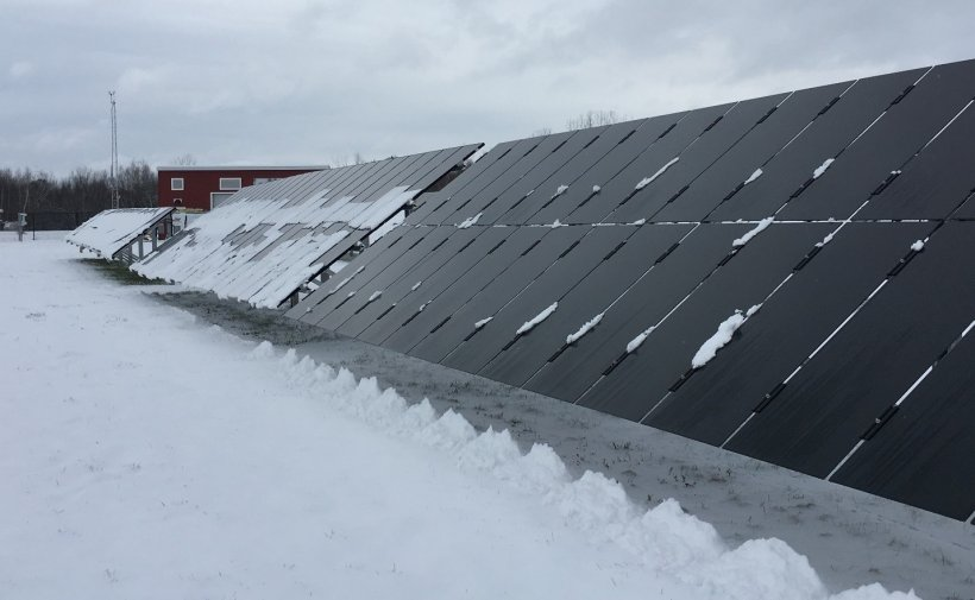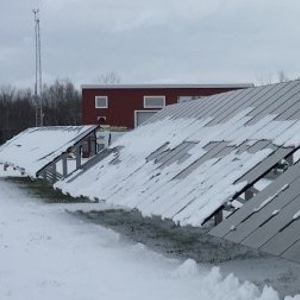The Challenge
Imagine – it’s the middle of winter in Minnesota. Snowstorms and frigid temperatures have left a layer of ice and snow on your solar-powered weather station, causing it to stop working. Can you design a self-cleaning solar station that can keep itself clean enough to keep operating throughout the winter?
Challenge: Design, build, and test, a self-cleaning solar station that can power itself and continually transmit weather sensor data by short-range radio.

Image courtesy of energy.gov
Team Composition
Sign up now (deadline is October 6, 2023, or 8 teams – whichever comes first) by writing to mnsgc@umn.edu.
Then attend a kick-off training event on October 19, 2023 (see below, option to attend remotely if necessary). Teams need to engage 3 students, minimum, with at least some gender and/or racial/ethnic diversity, as well as a faculty or adult adviser. (Note: 5 or 6 students might be a more-appropriate team size.)
Each team designs, builds, and tests their own self-cleaning solar station. Schools with more than 6 interested students are allowed to field multiple teams (that could share a faculty adviser), each of which would develop their own solar-powered station.
Training
Kick-off training for this challenge will take place at Augsburg University from 7–9 p.m. on Thursday, October 19, 2023. In-person attendance is encouraged (there will also be a streaming option).
A warm-up activity, described during the kick-off, needs to be completed by November 19, 2023. A set of starting materials will be provided to each institution at the kick-off, and mailed to those attending remotely. (Schools with multiple teams will only receive one set of starting materials.)
Required Reports
- Initial Performance Report (Video; due November 19, 2023), also known as warm-up exercise, demonstrating a device with the ability to point a solar panel toward the sun (i.e. track the sun) as it crosses the sky and also monitor the performance of the solar panel power output.
- Design Review (Written; due December 19, 2023) explaining what you plan to build, how it will power itself, how it will clean itself (and how it will decide when to clean itself), why the selected data the solar station will collect and transmit is relevant, and what types of tests your team plans to perform.
- Progress Report (Format TBD; due January 26, 2024) providing evidence that your solar station with self-cleaning capability has been built and is at least minimally functional in a clean, controlled setting. You should have procured all components for the design and have a mostly-assembled station by this point, with one month to go before final (public) testing.
- Performance Review (Video; due February 17, 2024) providing evidence that your station is capable of powering itself, self-cleaning, and transmitting data during (modest) snowfall and at temperatures below -10℃.
Final Public Testing
In-person final public testing on Saturday, February 24, 2024, at Augsburg University or the University of Minnesota (just across the river).
On this date each team will describe and demonstrate their self-cleaning solar station. Entries will be judged by their ability to power themselves in sunlight (or bright indoor light, if it is not sunny on that date) and continue to function, including self-cleaning as needed, when subjected to adverse environmental factors such as snow, mist, dust, etc.
Teams are required to send representatives (preferably the entire team) to the final in-person testing.
Minnesota Space Grant Consortium
www.mnspacegrant.org
Questions, or want to sign up?
mnsgc@umn.edu
